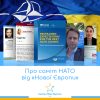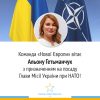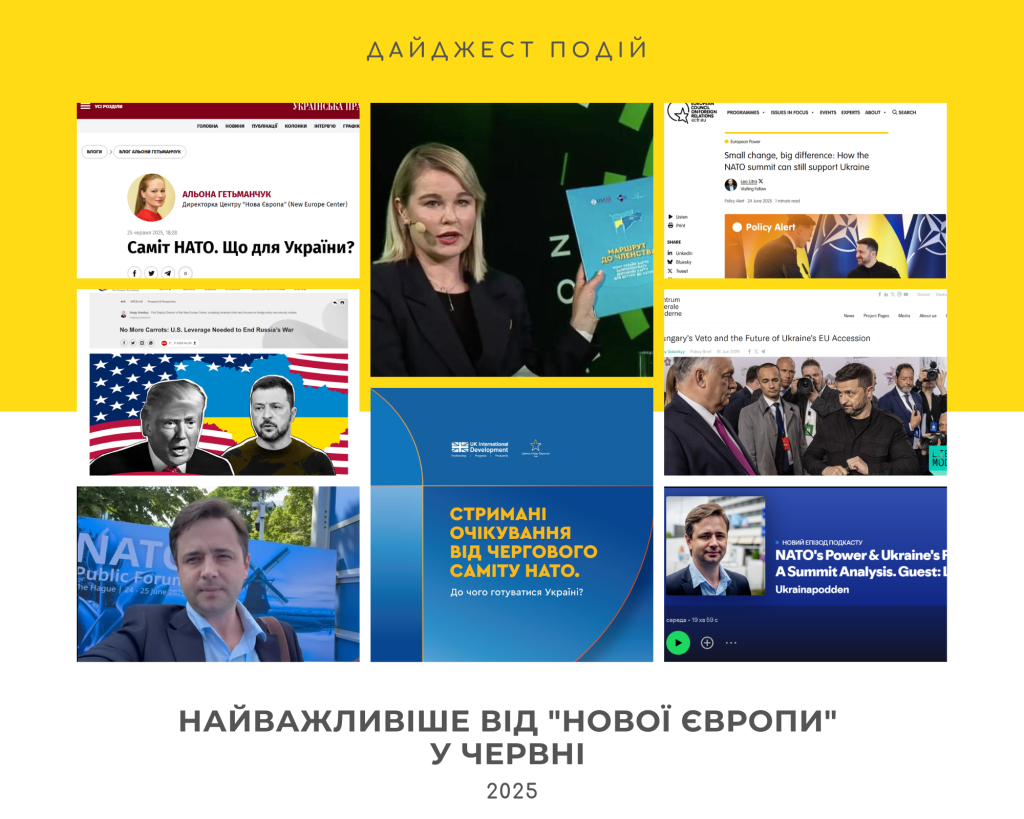Policy brief by Tetiana Levoniuk on Ukrainian-Slovak relations. Please find the PDF-version here.
The paper was written within the Think Tank Development Initiative for Ukraine (TTDI), carried out by the International Renaissance Foundation in partnership with the Think Tank Fund of the Open Society Initiative for Europe (OSIFE) with financial support of the Embassy of Sweden in Ukraine.
The views and opinions expressed in this paper are those of the author and do not necessarily reflect the position of the Embassy of Sweden in Ukraine, the International Renaissance Foundation, and the Open Society Initiative for Europe (OSIFE).
***
The author is grateful for the opportunity to pass an internship in Slovakia within the Think Tank Development Initiative for Ukraine (TTDI), carried out by the International Renaissance Foundation in partnership with the Think Tank Fund of the Open Society Initiative for Europe (OSIFE) with financial support of the Embassy of Sweden in Ukraine.
She would like to express gratitude to the Research Center of the Slovak Foreign Policy Association, especially to Alexander Duleba, for valuable advice and giving the opportunity to collect the necessary data for the research. The author is also sincerely grateful to the Ambassador of Slovakia to Ukraine Marek Šafin, Sergiy Solodkyy, Maryna Vorotnyuk, Jana Kobzova, Grigorij Mesežnikov, Mykhailo Honchar, Karel Hirman, Josef Bátora, Juraj Marušiak and all other experts for their contribution to the research.
The change of power in Ukraine and the election of the new President of Slovakia open a window of opportunity for the bilateral cooperation. The assassination of investigative journalist Ján Kuciak and his fiancée in February 2018 caused major changes in the Slovak political arena, and the victory of Zuzana Čaputová, a pro-liberal candidate, has become their symbol. These changes are likely to come to an end with the parliamentary elections scheduled for late February 2020, when the ruling camp will face the right-wing liberal opposition and anti-system radicals. In order to improve our relations in the new realities and establish systematic interaction, we will try to determine the areas where we are underutilizing the potential of bilateral cooperation, the existing threats, and the steps to facilitate the more fruitful cooperation.
The political sphere: are there no problems?
Free from historical burdens and troublesome issues, our relations haven’t yet become systematic, remaining a tale of underestimated opportunities. Despite the different political colors of the Slovak governments, Slovakia is interested in cooperation with Ukraine and its European integration.
According to the Slovak interlocutors, there is a feeling that their country is perceived by the Ukrainian political elite as a small neighbor, unable to provide sufficient assistance to Ukraine. Moreover, it is incomprehensible that the former President of Ukraine has never visited Bratislava with a full-fledged visit, as meetings at international venues are not an equivalent substitute. The Slovaks note that many in Kyiv still think that “if they manage to make arrangements with Brussels, Berlin, or Warsaw, Bratislava will support it.”
Ukraine and Slovakia remain “terra incognita” for each other, perhaps due to the lack of interest. However, Slovaks have always been sympathetic to the ideas of Pan-Slavism. Pan-Slavism was first formulated by Czech and Slovak intellectuals in the mid-nineteenth century. This ideology reflected the desire to unite all Slavic peoples. Russia, in its turn, had been perceived by Slovak nationalists as the only ally to become the defender of the Slavs.
The events of 1968 also did not have such a negative impact on the Slovaks as on the Czechs, given that after the suppression of the Prague Spring, Slovak nationalists had been appointed to important government positions. For example, Gustáv Husák, a leading figure in the Slovak national uprising in 1944-1945, had become Secretary General of the Communist Party of Czechoslovakia in 1968. Furthermore, the Communist regime contributed to the modernization of the Slovak economy. In 1960-1970, it underwent forceful industrialization, which created new jobs and significantly improved the living conditions of the Slovaks.
It is unlikely that one can find a negative experience of relations with Russia in the history of Slovakia. This is what makes Slovakia’s “post-Communist” perception of Russia unique in the Central European region. According to the Globsec poll, conducted in 2018, 41% of the Slovaks supported Putin’s policy, while 49% disagreed with Poroshenko’s policy[i]. One third of the respondents did not believe that the conflict in the East of Ukraine was ongoing due to the presence of Russian troops. This year’s poll showed that 46% of Slovaks see their country as a bridge between the East and the West, while 10% chose the East as a priority. Among the Slovaks, there is also the strongest tendency towards conspiracy theories in Central Europe and strong anti-American sentiment (41% consider the United States the enemy)[ii].
In general, Slovakia is following a common course across the European community. Former President Andrej Kiska has openly condemned Russian aggression against Ukraine, supported the anti-Russian sanctions and Ukraine’s European aspirations. The current Slovak president, Zuzana Čaputová, shares his position: “I will continue supporting Ukraine,” she said in an interview during her visit to Brussels. “Each country has the right to decide independently to where it wants to belong.”[iii] Zuzana Čaputová’s official visit to Ukraine during the first 100 days of her presidency is a vivid example of Ukraine’s importance as a partner. It could set the tone for the Slovak discourse on Ukraine. The Slovak Ministry of Foreign and European Affairs also has a legacy of issues around Ukraine. Foreign Minister Miroslav Lajčák notes that Ukraine is not a temporary concern for Slovakia; on the contrary, Slovakia is interested in Ukraine remaining on the European agenda [iv].
Former Prime Minister Robert Fico (leader of the left-wing party Smer-SD), known for his statements on the counter-productive nature of anti-Russian sanctions and flirting with the Kremlin, has a different approach to Russia. However, his Government agreed to all restrictive measures against Russia approved by the EU and implemented reverse natural gas supply to Ukraine, despite the probability of Fico’s disappearance from Russia’s friendship list after such a move). The current Prime Minister, Peter Pellegrini (a member of the Smer-SD party), who, according to the Slovak interlocutors, holds the post only nominally, has not shown himself in the context of the policy toward Ukraine: he is simply silent about it. The contradictions in the rhetoric of politicians and their actions are quite simple to explain: politicians usually make statements that their constituents would like to hear. The average Slovaks perceive Russia mostly favorably. Moreover, no matter how pro-Russian, in critical moments provoked by Russia’s destructive policies, Western partners provided maximum support to Bratislava (for instance, during the 2009 natural gas crisis).
For a part of the Slovak political circles, the Russian prism of perception of Ukraine is quite close. Russian narrative about the war in Donbas, as well as the established opinion of Ukraine as a “failed state” states is popular among them. For example, Speaker of the Slovak Parliament Andrej Danko opposes the EU policy towards Russia and maintains active contact with Russian Speaker Vyacheslav Volodin. His right-wing conservative Slovak National Party (SNS), which is part of the coalition government, has blocked the implementation of revised security and defense strategies for Slovakia in the summer of 2018. The reason for this move was certain articles where Russia was described as an aggressive state. Other examples include last year’s visit to annexed Crimea by MP Peter Marček, together with several businessmen and a former Deputy Head of the Slovak Intelligence Service, which has been openly condemned in the coalition government only by the leader of the Most-Hid (liberal party representing the Hungarian minority); and the decision not to expel Russian diplomats after the Salisbury events.
Another threat to Ukrainian-Slovak relations might be the changes in Slovakia’s policy towards Ukraine in the wake of the February 2020 parliamentary elections. In 2014, Robert Fico lost the presidential election, and in 2016, Fico’s party had to form a coalition government, as it lost the majority with 28% of the votes[v]. The recent elections to the European Parliament won by the PS-SPOLU coalition of the newly formed pro-European parties SPOLU and Progressive Slovakia (whose Vice-President was Zuzana Čaputová) have become another signal of the weakening of Fico’s political force[vi]. Accordingly, Čaputová’s victory is the next phase in a wave of changes in Slovak politics. Certain Slovak interlocutors have expectations that after the parliamentary elections, Slovakia will get a new Government, an alternative to Fico. There are also those who point out the likelihood of partitioning of the party due to the conflict between Robert Fico and Peter Pellegrini.
The Slovak political space is rather segmented: apparently, nine parties will get to the Parliament. The current opposition, which also includes the political force of the country’s President, has every chance of forming a government coalition. It can be joined by five parties at once: the PS-SPOLU coalition, Za ľudi (the former President Kiska’s party), SaS (a minor liberal center-right party), OĽaNO (another minor conservative party) and the Christian Democratic Movement (KDH) (formerly a part of the government coalitions). PS-SPOLU and KDH have recently signed a non-aggression pact for the duration of the election campaign[vii].
There are also undecided voters, which could change the balance between parties, allowing Fico’s Smer-SD political force (still in the lead with 19.6% of support) to get more votes and agree on a coalition with Boris Kollár’s non-system party Sme Rodina and even with the right-wing radical People’s Party – Our Slovakia (L’SNS) led by Marian Kotleba. On September 3, the Slovak Supreme Court formally revoked the mandate of MP Milan Mazurek (L’SNS). The reason was his racist statements on the Romani people, and this was the first such case in the country’s history. It is noteworthy that Fico publicly defended this MP.
According to the latest poll conducted by AKO, L’SNS received 10.9%[viii]. Party members are fascinated by the puppet government that ruled Slovakia during World War II. This party is called openly pro-fascist, with anti-Roma and anti-Semitic positions, and its support is partly explained by the Slovaks’ desire to express a kind of protest. Some interlocutors also noted that Kotleba’s party was underestimated, especially after his victory in the regional elections in Banská Bystrica. In the elections to the European Parliament, this party took third place.
Following the recent refusal of Štefan Harabin, a far-right presidential candidate, to run for Supreme Court judge, he is likely to form his own party. Former Health Minister Tomáš Drucker, previously a member of the Smer-SD party, is also in the process of creating a new political force.
Economic cooperation: untapped potential
Contrary to the myth that the anti-Russian sanctions are significantly detrimental to the economies of the EU Member States, including Slovakia, according to the research conducted by the New Europe Center, in 2014-2017, Slovak exports to Russia have decreased by only 3.7%[ix]. At the same time, Russia’s share of total imports to Slovakia in 2018 was 5.3%, while the share of Slovakia’s exports to Russia was 1.9%[x].
However, economic cooperation between Slovakia and Ukraine is also not very active. In 2018, the bilateral trade totaled USD 1,389.8 million and increased by 19.3% compared to 2017. The positive balance for Ukraine during this period amounted to USD 338.2 million[xi].
It is noteworthy that the last meeting of the Joint Commission on Economic, Industrial and Academic and Technical Cooperation has been held in September 2013. This intensity of the Commission’s activity is an example of the underestimation of economic cooperation or ineffective interagency communication. Moreover, the management of small and medium businesses in Slovakia often does not trust the unpredictable business environment of Ukraine.
Ukraine mainly exports and imports raw materials to/from Slovakia. Among the promising areas of cooperation are the automotive industry, metallurgy (not raw materials, but products with higher added value), aviation (in particular, R&D and education or joint projects), tourism, and transit. Collaboration in technological innovations and start-ups could also be interesting.
Slovakia and Ukraine have great potential for promoting the tourism and recreation industry. According to the World Economic Forum, over the past two years, Ukraine has risen by 10 points in the Travel and Tourism Competitiveness Index[xii]. Last year, the first meeting of the Ukrainian-Slovak Joint Travel Commission has been held, which was a good start for cooperation, as well as the launch of a flight from Bratislava to Odesa. It would be expedient to launch a tourist website and a corresponding tab on the web-page of the Embassy of Ukraine in Slovakia. It would also be interesting to invite popular travel bloggers or influencers from Slovakia to Ukraine and vice versa with the further promotion of a series of video commercials among the Slovak and Ukrainian audiences.
We should also note the exchange of experience between the Slovak Ministry of Finance experts and their Ukrainian counterparts: assistance with reforms, including support to market development through the SlovakAid program[xiii] and the activities of Ivan Mikloš, a former Slovak government official and Chairman of the previous Cabinet’s Strategic Advisory Group for Reform Support.
Energy sector: a long-term partnership or a post-Maidan episode?
The energy sector could be considered a locomotive of the cooperation between Ukraine and Slovakia. The project to reverse natural gas supplies from Slovakia to Ukraine through the Voyany-Uzhgorod pipeline demonstrates Slovakia’s strategic importance in Ukraine’s energy security. In 2018, Slovakia’s share of natural gas transit from Europe to Ukraine was 81.4% (compared to Poland’s 2.9%)[xiv]. Further transit of Russian natural gas to Western Europe and counteracting the Nord Stream 2 project, given the prospect of its launch in a couple of years, is another mutual interest of the two countries.
The process of unbundling is also underway[xv], which means that an independent GTS operator should emerge, which will impact further communication with partners and involvement of the Europeans, including the Slovak company Eustream, in the full management of the GTS of Ukraine. Failure of the unbundling process would result in systemic problems affecting the internal natural gas and market and its transit. The contract between Naftogaz and Gazprom, which expires on January 1, 2020, should also be considered. Slovakia is interested in further cooperation on reverse supply and, if necessary, is able to increase the capacity and security of the Voyany-Uzhgorod pipeline. In this case, Ukrainian communication strategy and direct interaction with the Slovaks after January 1, 2020 will be critically important. It is advisable to establish a “hotline” at corporate and ministerial levels to avoid the same communication gap as in 2009.
Another promising aspect of cooperation is the implementation of energy efficiency and renewable energy projects, as well as the implementation of Slovak best practices in this field. Today in Slovakia, over 50% of panel houses are insulated and modernized, which is one of the best figures among all the post-socialist European countries. Thermal modernization of the Slovak housing stock has been launched in the early 1990s; thus, today Ukraine can learn from the best and already adapted to post-Soviet infrastructure practices avoiding mistakes. For instance, the experience of a fully energy-independent Slovak town of Trnava, or that of the Thermonova a.s. TPP in Nova Dubnica, which operates on biomass, providing heat and electricity for 12,000 people could be interesting. The Slovak experience was also useful in establishing the Energy Efficiency Fund in Ukraine.
On top of that, Slovakia could help Ukraine integrate into the emerging Central European electricity market. The gradual involvement of Ukraine in the establishment of a regional energy market is a long-term goal; nevertheless, it should be seen as a strategic basis for the bilateral Ukrainian-Slovak energy cooperation. Cooperation with Slovakia will be useful for further connection of Ukraine to the ENTSO-E (European Network of System Operators). However, Ukraine should have a clear plan for joining the ENTSO-E with realistic and achievable goals and deadlines. Currently, one of the priority projects is the reconstruction of the Mukachevo – Veľké Kapušany transmission line, which will allow to expand its capacity.
Ukraine’s underground natural gas storage facilities could become the basis for future gas storage cooperation granting the preconditions for the establishment of an Eastern European natural gas hub based on the gas markets of Ukraine, Slovakia, Poland, Czech Republic, Hungary, and Romania. In July, German company RWE, one of the key actors in the European natural gas market, used a “customs warehouse” natural gas storage service in Ukraine. If this experiment is successful, other interested partners will come. The interconnection of the GTS of Slovakia and Poland should be completed by 2021. Ukraine becomes a member of the North-South energy corridor. New opportunities for cooperation with the neighbors are likely to emerge in the future.
Thus, the moment that has emerged in the Ukrainian-Slovak energy cooperation since the Maidan should be captured in bilateral relations if we are to make our partnership truly long-term.
Integrated border management and cross-border cooperation
The cooperation between Transcarpathia and Eastern Slovakia is based on common problems: economic, infrastructure, etc. It has been established with the emergence of the Carpathian Euroregion in 1993 with the participation of the border regions of Ukraine, Poland, Slovakia, Romania, and Hungary. The scale of this Euroregion has made its functioning and institutional development difficult. This format requires reorganization. The movement of people, transport, and goods across borders is more dependent on the state of relations between Ukraine and the EU; however, the Ukrainian-Slovak component in the cross-border cooperation is lacking.
In order to bring the border regions closer together, it would be advisable to establish a new bilateral Euroregion, with higher organizational and institutional quality, or to launch a fund for Transcarpathia and Košice or Prešovsky self-governing region to select and finance joint projects. Among the obstacles for the development are the lack of internal funding (dependence on the EU funds) and the instability of projects that have already been implemented. And, of course, such cooperation depends on the political will of the two countries.
Another important aspect is the introduction of joint border control, which would significantly reduce crossing times at border points and increase the efficiency of movement of people, goods, and vehicles. As of today, we observe a lack of joint planning and the problem of underdeveloped border infrastructure. Establishing logistics centers to provide a wide range of services could be also a good solution.
In order to stimulate the economic development of the Eastern regions of Slovakia and Transcarpathia, it would be expedient to focus on economic development projects. Business forums (as the one launched in Košice) or fairs, for example, “MadeinUkraine”, etc. are potentially promising. These arrangements could be reached within the framework of the meeting of the Joint Commission on Cross-border Cooperation.
The resumption of functioning of the Uzhhorod International Airport, which is unique as the aircrafts take off and land through the airspace of Slovakia, has become a good example of cooperation between Ukraine and Slovakia in improving the living conditions of residents of the border region. This could give momentum to tourism development not only in Transcarpathia but also in border regions of Slovakia. Airports in Uzhhorod and Košice are strategically important for the border regions; therefore, coordinating their development could be beneficial. It is also worth noting the launch of the Košice-Mukachevo train in June this year. The construction of an airport in Mukachevo, announced by the previous Government[xvi], is also a promising project.
Ukrainians in Slovakia
The number of Ukrainians in Slovakia is steadily increasing. Students and migrant workers are becoming a new element of our relations. With proper approach and coordination, they could disseminate positive messages among Slovak audiences, explaining the specifics of Ukraine.
The demographic decline in Central European countries and the departure of working-age population to Western Europe have prompted Slovakia’s interest in additional labor force from third countries and a change in its migration policy. According to estimates, the number of Slovak working-age population will decrease by 37% from 2013 to 2060[xvii]. In November 2018, the Slovak Government agreed to further amendments to the laws on employment services and the stay of foreign nationals in order to facilitate the employment of third-country nationals.
The share of Ukrainians in the structure of foreign labor migrants in Slovakia has reached 13.2%[xviii]. For comparison, in 2014, it was 4.9%. By the end of 2018, nearly 25,000 citizens of Ukraine have been staying in Slovakia, of which 20,5 thousand were temporary and 4,4 thousand were permanent residents[xix]. This makes them the largest group of third countries nationals residing in Slovakia. We should also take into account illegal migrants, whose exact number is not available, but, according to our Slovak interlocutors, half of those migrants are Ukrainians. According to a specialized research, the issue of economic migration is very toxic and gives rise to various myths among the Slovaks; however, this issue does not touch Ukrainian labor migration[xx].
The rapid increase in the number of Ukrainian students over the past few years has also coincided with the sociodemographic trends. Both the absolute number of Ukrainian students (from 188 full-time students in 2013/2014 to 1,851 in 2017/2018), and the share of Ukrainian students among all foreign students in the Slovak Republic (from 3% in 2013/2014 to almost a quarter of all foreign students in 2017/2018) have increased[xxi]. Student exchanges, academic clusters, and dissemination of Ukrainian messages among young people by the students will help strengthen the positive image of Ukraine among the Slovaks and gradually move away from the context of corruption and war in their perception of Ukraine.
Recommendations:
- Organize a visit of the President of Ukraine to Slovakia. Volodymyr Zelenskyy’s visit to Bratislava would demonstrate how Ukraine values Slovakia’s support in various areas. Currently in Slovakia, attention is drawn to the imbalance of visits: the Slovak top-level officials have been much more likely to visit Ukraine than their Ukrainian counterparts have been to visit Slovakia.
- Enhance the dialogue with Slovak “friends of Ukraine”. Investing in communication at the level of experts, opinion leaders, and media in Slovakia is vital. There are not enough experts in the country who know about the internal situation in Ukraine and are able to provide competent comments. Ukraine is most often associated with war, corruption, and Crimea. Expert and journalist visits (such as study tours), joint think tank projects, and academic exchanges are critically important.
- Establish an intensive inter-parliamentary partnership. The Slovak direction of bilateral interparliamentary cooperation should be the responsibility of MPs who understand the Slovak specificity or at least have an idea of cooperation in Central Europe. Following the parliamentary elections in Slovakia in February 2020, the composition of the National Council is likely to be substantially renewed, and the Verkhovna Rada of Ukraine has also changed its composition. The exchange of visits by “friendship groups” of the two countries would be a good start for establishing contacts, and Ukraine could take the initiative in this sense.
- Focus on Ukrainian-Slovak cross-border cooperation. Consider establishing a joint fund for Transcarpathia and Prešov or Košice self-governing regions to select and fund joint projects on an ongoing basis. This issue could be discussed during a meeting of the Ukrainian-Slovak Intergovernmental Commission on Cross-border Cooperation.
- Implement the integrated border management and increase the capacity of border crossing points between Ukraine and Slovakia. This would help solve the problem of long lines at the border.
- Maintain active communication with the Ukrainians of Slovakia, who are becoming a significant part of the Slovak society. It is about both Ukrainians living in the country for a long time and those who have just arrived: students or migrant workers (their number is steadily increasing). The more the Slovaks know about Ukraine, the more opportunities there will be to counteract the Kremlin’s anti-Ukrainian activities, and the further we will depart from the image of Ukraine as a “terra incognita” in the minds of Slovaks.
- Cooperate more actively with Slovak counterparts on energy security in the region. It would be expedient to set up a “hotline” at the corporate and ministerial levels starting from January 1, 2020 to avoid a communication gap. Continue exchange of experience between Slovakia and Ukraine in the field of energy sector reforms. Slovakia is able to share with Ukraine its experience of adapting national legislation to the EU energy policy, energy audit, energy conservation, biomass utilization and more.
- Complete the unbundling and involve European partners, in particular Slovak Eustream, in the management of the GTS of Ukraine. The Slovak company is interested in participating in a full-fledged consortium after the establishment of an independent GTS operator of Ukraine.
- Have a clear strategy with deadlines and tasks for connecting to the ENTSO-E pan-European energy system. The important steps during the implementation of this strategy will be the reconstruction of transmission lines and the reinforcement of shared grids in accordance with ENTSO-E safety standards.
- Improve the mechanism of informing Ukrainian manufacturers about the procedure for entering the Slovak market and other technical details. This could be facilitated by coordinated work at all levels: Council of Exporters and Investors at the Ministry of Foreign Affairs, Chambers of Commerce, FEA Offices at the regional state administrations, etc., which would allow avoiding duplication of functions. A joint organization of a start-up fair or a “MadeinUkraine” exhibition to increase and diversify Ukrainian exports could be one of interesting activities; it is also important to continue organizing Slovak businessmen’s missions to Ukraine and holding joint business forums.
Works Cited:
[i] GLOBSEC Trends 2018 Central Europe: One Region, Different Perspectives,
[ii] GLOBSEC Trends 2019: Central and Eastern Europe 30 years after the fall of the Iron Curtain, https://www.globsec.org/publications/globsec-trends-2019/
[iii] President of Slovakia spoke about support for Ukraine and her vision for dialogue with Russia, https://www.eurointegration.com.ua/news/2019/06/26/7097778/
[iv] SR-Ukrajina: Politické rokovania i humanitárna pomoc, https://www.mzv.sk/aktuality/detail/-/asset_publisher/Iw1ppvnScIPx/%20content/-sr-ukrajina-politicke-rokovania-i-humanitarna-pomoc/10182
[v] The 2016 elections in Slovakia: a shock, https://cz.boell.org/en/2016/03/22/2016-elections-slovakia-shock
[vi] EP election in Slovakia: Official results confirm the victory of pro-EU forces, https://spectator.sme.sk/c/22130284/ep-election-in-slovakia-official-results-confirm-pro-eu-forces-prevailed.html
[vii] PS, Spolu a KDH sachcú rozprávať slušne, majú paktoneútočení (video), https://video.sme.sk/c/22164806/progresivne-slovensko-spolu-a-kdh-maju-pakt-o-neutoceni-video.html
[viii] Prieskum: Kiskova strana sa doťahuje na SaS, kotlebovci klesli, https://www.aktuality.sk/clanok/721354/prieskum-kiskova-strana-sa-dotahuje-na-sas-kotlebovci-klesli/?fbclid=IwAR0t8rAF-30eU4lNH6aMN8S7IhB6WEGvca6S7HgAWjrsd2fvksQvHCyQEIs
[ix] Who Will Be the First? Which Countries Would Dare to Violate the Unity of the European Union Against the Sanctions Imposed on Russia? http://neweurope.org.ua/analytics/hto-pershyj-yaki-krayiny-navazhatsya-porushyty-yednist-yevropejskogo-soyuzu-shhodo-sanktsij-proty-rosiyi/
[x] Total Import and Total Export by continents and economic groupings, http://statdat.statistics.sk/cognosext/cgi-bin/cognos.cgi?b_action=cognosViewer&ui.action=run&ui.object=storeID(%22i10B2CB52FFF44B319DA31F65A3FFE155%22)&ui.name=Total%20Import%20and%20Total%20Export%20by%20continents%20and%20economic%20groupings%20in%202014%20%5bzo0002ms%5d&run.outputFormat=&run.prompt=true&cv.header=false&ui.backURL=%2fcognosext%2fcps4%2fportlets%2fcommon%2fclose.html&run.outputLocale=en
[xi] State Statistics Service, http://www.ukrstat.gov.ua
[xii] Travel & Tourism Competitiveness Index, https://www.weforum.org/reports/the-travel-tourism-competitiveness-report-2019
[xiii] MF SR development cooperation activities, https://www.finance.gov.sk/en/european-international-affairs/development-cooperation/mf-sr-development-cooperation-activities/
[xiv] In 2018, Ukraine purchased 10.6 billion m3 of natural gas from the European direction, http://www.naftogaz.com/www/3/nakweb.nsf/0/2AFFDE2203E7BBA3C22583900050CD59?OpenDocument&Highlight=0, Словаччина
[xv] Unbundling is the process of separation of natural gas transportation activities (the activities of the GTS Operator) from the production and supply of natural gas and electricity.
[xvi]The launch of the construction of the airport in Mukachevo has been announced, https://pershij.com.ua/anonsovano-pochatok-budivnytstva-letovyshcha-v-mukachevi/
[xvii] Phantom Menace. The politics and Plocies of Migration in Central Europe. Jacek Kucharczyk and Grigorij Meseznikov (eds.). Institute of Public Affairs, 2018. 267 p.
[xviii] Ibid.
[xix] https://www.minv.sk/swift_data/source/policia/hranicna_a_cudzinecka_policia/rocenky/rok_2018/2018- rocenka-UHCP-SK.pdf
[xx] Myths and facts on Ukrainian labour migration to the Visegrad group, https://europewb.org.ua/wp-content/uploads/2019/05/Giude-EN-fin.pdf
[xxi] Ukrainian students abroad: data up to 2017/2018 academic year, https://cedos.org.ua/uk/articles/ukrainske-studentstvo-za-kordonom-dani-do-201718-navchalnoho-roku







